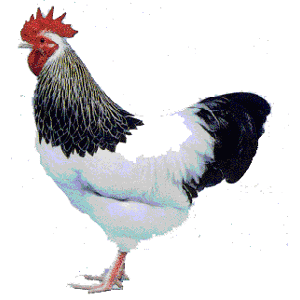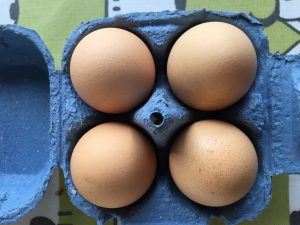
Overview
The Sussex is a very old English breed, which originated in the County of Sussex more than a century ago. It was exhibited in the 1840’s the first recorded colour being the spangled or speckled. It was primarily bred for market purposes, Sussex being famed for its production of table fowls. Probably Britain’s most popular breed, most people can recognise the distinctive plumage of the Light Sussex.
They also exist in Silver, Buff, Red, Brown and White. Sussex fowls featured in the first poultry show in 1845.
Male: 8.9 – 9.26lbs (4-4.2 kg) Hen: 6.6 – 7lbs (3-3.2 kg)
Bantam Male 2.2 – 2.65lbs (1-1.2kg) Bantam Hen: 1.7 – 1.7 lbs (780-800g)
Eggs
Size
Large
Color
Light Brown / Cream
Production per year
180-250 per annum (the buff variety lays the most)
When do they start laying eggs?
18-25 weeks, they are a fast maturing bird.

Sussex Characteristics
Temperament / Are they good as pets?
They are alert and upright but also very docile, so make great backyard pets. Good with children too and make a great chicken breed for beginners or someone new to keeping chickens. They are an all-round good bird, as they are so easy to keep and are very hardy.
England has average temperature lows of 32°F (0°C) and average highs of around 86°F (30°C) so would be best kept within this temperature range, however they are hardy and could possibly thrive in hotter or colder climates.
How do I tame Sussex chickens?
Quite easily, begin with interacting around them so they become used to your presence, then start to throw some feed or treats near to them so they begin to associate you as being safe and trust worthy. They will then start to feed from your hand, and allow you to pick them up. Make sure you hold them properly as they are a large bird.
How many do I need to buy?
Would be great on their own but id recommend purchasing in pairs so they don’t get lonely. Singularly if you have an existing flock, would be ok too. I normally recommend 6 chickens, its a great backyard flock size. What I recommend is for every 10 female Sussex’s you should have 1 male.
How much space do they need?
They love to forage and are great at it, so would work well free range. They are classed as a large bird but any chickens require around 25 square feet in the coop run. Id add a bit more to that estimation however given their size.
Will they mix with my other chickens?
If you have an existing backyard flock and the Sussex is one chickens you’d like to introduce, then they would be very suitable for this as they mix well. I’ve not seen any bullying from or to other chickens from this breed as they are docile.
Appearance
Very well known for its white feathers in the light variety. They have broad shoulder and a flat wide back. They are said to have an almost rectangular build. The tail is held up at 45 degrees. They have a single comb, which is red, the ear lobes are red too.
Feeding
What should I feed them?
This is simple and well documented from 0-6 weeks old feed them chick crumb this contains all the correct nutrients for their growth at this stage.
At 6 weeks change the feed for ‘growers mash’ this will take them upto 18 weeks.
At 18 week they will be on ‘the point of lay’ meaning they will be very close to laying your lovely eggs so need a ‘layers pellet’ this contains everything they need to help lay and should be fed this for ever more. A mature laying bird will require grit.
How much should I feed them?
Despite being a large bird, they won’t eat any more than any other breeds. So don’t cost a small fortune to raise and keep – thankfully. If free range they will also supplement a lot of the food you feed them with insects etc from the backyard, as they are good foragers, so free range is best. However they should be fed between 2.9oz (80g) and 4.2oz (120g) a day like any other chicken.
What can’t they eat?
Firstly chocolate – that might have supposed you, but chocolate and chickens don’t mix. The theobromine in it can cause fatal heart issues. Chocolate isnt likely to be accidently fed to your chickens but the next one is – beans.
Infact even more potent, if that’s even possible, is if their dried beans. Again like chocolate it can cause cardiac arrest in chickens. Be very careful therefore if feeding chickens scraps from the table as it may contain hidden beans. Feeding chickens scraps in the UK is banned – so be aware. Also remember that if your Sussex’s are free range to make sure they can’t get access to bean plants.
To read in depth about feeding chickens click our chicken feed page
What do I need to keep chickens?
- You’ll need a coop! Somewhere for them to live is top of the list, Sussex require a roost height of 2-4ft so a coop well of the floor is needed I’d recommend this
- Next is something to drink – water. You’ll therefore need a waterer! Place this in the shade, and change the water daily as a minimum. Chickens prefer cold water I always find a metal waterer will keep the water cooler for longer when outside, compared to plastic one. They are a few more bucks admittedly but last so much longer, the investment will pay for its self. Heavier as well so won’t get knocked over as easily. More and more information on plastics is coming to light mainly about it leaching into the water, and largely plastics are bad for the environment so if you can, choose a metal one.
- A feeder they are going to need to eat! Quite a few options again I’d recommend something like this
